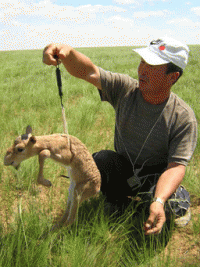This project, by a young researcher at the Institute of Zoology in Kazakhstan, will help to train the next generation of saiga experts as well as providing important information on the current status of the saiga population in Betpak-dala.
 This was one of the most severely affected populations by the poaching crisis at the end of the 1990s, being the closest to the capital city, Almaty. Now although there are suggestions of stabilisation, the population is still perilously low.
This was one of the most severely affected populations by the poaching crisis at the end of the 1990s, being the closest to the capital city, Almaty. Now although there are suggestions of stabilisation, the population is still perilously low.
The Betpak-dala range area is very large, and is currently subject to an ambitious programme of nature protection through the creation of a vast new protected area system. However, we need current information on the distribution of saigas if we are to plan effectively. The sex and age structure of the population, and the calving rate, provide important information on the status of the species in this area, and can be compared to similar data collected over many years by the Institute of Zoology. This sort of scientific research is crucial for monitoring the recovery of the saiga population, and for ensuring that any warning signs are quickly picked up.
It is also vital that we build capacity in-country for research and management of saiga populations, and supporting the work of a young scientist, who is working with Kazakhstan’s preeminent saiga experts, is a first step towards this.
Photo: A researcher weighs a saiga calf. (c) Nils Bunnefeld
